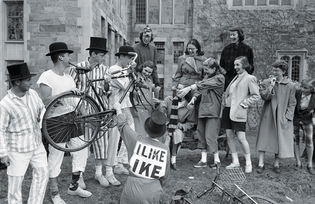
Yale Joel/The Life Picture Collection/ Shutterstock
Vassar students greeted a team of costumed Yale men who had just competed in the first Trumbull Beer and Bike Race in 1952.
View full image
In the spring of 1952, a student in Trumbull College said he could ride the 77 miles from New Haven to Poughkeepsie, New York, between sunrise and sunset. When a friend challenged him to prove it, the offhand boast launched a tradition that epitomized both the frivolity and the mating rituals of 1950s college life: the Trumbull Beer and Bike Race.
Poughkeepsie was anything but a random destination. It’s the home of Vassar College, which was then a women’s college with deep social ties to the all-male Yale College. And that undergrad in Trumbull, Conrad Normann ’52, had a very specific reason to make the trip: his girlfriend, Peggy Monroe, was a senior there.
Somehow, Normann’s ride evolved into a relay race, and 18 five-man teams from Trumbull signed up to compete. A twist was added: after each cyclist finished his leg of the race, he would have to drink a quart of beer before his next teammate could begin.
Normann enlisted Peggy Monroe to coordinate the reception of the cyclists at Vassar—where students were waiting enthusiastically for dozens of bicycling college men. The finish-line welcome would include a trumpeter, drum majorettes, the Flora Doras singing group, and a student dressed as college namesake Matthew Vassar (who had made his fortune as a brewer). The 90 competitors would be rewarded with a swim in the college pool (“Get your seats early,” the student-run Vassar Chronicle advised its readers), dinner at a local restaurant, and a dance. Perhaps most importantly, the Chronicle reported that “each racing participant is assured a Vassar date for the evening.”
As the race date approached, the media grew more interested. The combination of elite colleges, athletic competition, beer guzzling, and runaway hormones made for a good story in an era when America delighted in student antics. (Think swallowing goldfish and stuffing themselves into phone booths.) Life covered the race and later published a six-page photo spread. Movietone News and local TV stations also joined in. For prizes, a bicycle manufacturer put up five new bikes for the winning team, and the Arthur Murray dance studio kicked in $250 worth of free dance lessons. And just to make sure the cameras got their money’s worth, the competitors wore absurd costumes and gave themselves suggestive team names that emphasized the real motive for the trip, among them the Maidenform Five, the Philanderers, and the Undersextet.
On the day of the race, the road to Poughkeepsie was clogged not only with the competitors but also the media, race officials, and Yalies in cars who didn’t want to miss out on the fun. After four hours and forty-five minutes, Steve Hutchcraft ’52, the anchor of the Undersextet, crossed the finish line first. (Organizer Conrad Normann rode the third leg for the winning team.)
Summing up the event in the Chronicle, Peggy Monroe wrote: “By 1:00 a.m., less than twelve hours after their momentous arrival, Yale—comfortably established in sedans—was cruising home. And since then people have been asking me if I thought the affair was a success, and I roar a mighty affirmative.”
It was certainly a boost for the residential college at the center of the race. Trumbull was considered low on the Yale social ladder in those days. At a time when students chose their colleges, a Trumbullian in the 1953 Class Book wrote that “only one member of the Trumbull Class of 1953 elected Trumbull as his first-choice residential college when applications were made during freshman year. . . . Trumbull was not a popular college. It was not socially ‘shoe’ nor was it the home of the prominent University athletes.” The spotlight on the Beer-Bike Race, which was open only to Trumbull students, must have bolstered the college’s reputation.
The races from Yale to Vassar continued through 1955. In 1956 the race was canceled, apparently because Yale students had brought alcohol into Vassar’s dry campus. It was reinstated in 1957, but that was the last race with Poughkeepsie as a destination. Beginning in 1959, the cyclists rode to Connecticut College in New London. By 1963, according to that year’s race program, “no girls’ school could be found that would graciously accept America’s finest cyclists,” so the organizers designed a circuit through the towns north of New Haven.
After the 1964 race, Trumbull’s master and dean announced its cancellation due to complaints about the bawdy skits that preceded the race and to opposition from the towns on the route. The 1965 Class Book reported that “the pre-race festivities reached their nadir, and the race itself was somehow lost amidst numerous confused riders and distraught policemen at intersections.” In 1974, the Yale Daily News reported on a revival in which riders went to East Rock and back—but it was hardly the hero’s journey that had been immortalized in Life in 1952.
The Beer and Bike Race came and went in 13 years. Conrad Normann and Peggy Monroe outlasted it by decades: they were married in 1953 and stayed that way for 52 years, till death did them part.
 loading
loading